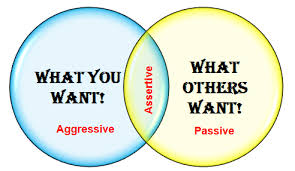
CASE of DEBRA. Debra’s patience is beginning to wear thin with her colleague Ronan. A few days earlier he had undermined her yet again, this time in front of other colleagues during the weekly team meeting.
So, she decided to tell him how he made her feel. But just as she was about to approach him, she lost her nerve.
It’s possible that you’ve been in a situation like Debra’s and, like her, you might have felt unable to do anything about it. But by learning how to be more assertive, you can stand up for yourself, and become a strong and confident communicator.
In this article, we look at why assertiveness is important in the workplace and explore some strategies that you can use to become more assertive.
What Is Assertiveness?
It’s not always easy to identify truly assertive behavior. This is because there’s a fine line between assertiveness and aggression, and people can often confuse the two. For this reason, it’s useful to define the two behaviors so that we can clearly separate them:
- Assertiveness is based on balance. It requires being forthright about your wants and needs, while still considering the rights, needs and wants of others. When you’re assertive, you are self-assured and draw power from this to get your point across firmly, fairly and with empathy.
- Aggressive behavior is based on winning.You do what is in your own best interest without regard for the rights, needs, feelings, or desires of other people. When you’re aggressive, the power you use is selfish. You may come across as pushy or even bullying. You take what you want, often without asking.
So, a boss who places a pile of work on your desk the afternoon before you go on vacation, and demands that it gets done straight away, is being aggressive. The work needs to be done but, by dumping it on you at an inappropriate time, he or she disregards your needs and feelings.
Example – When you, on the other hand, inform your boss that the work will be done but only after you return from vacation, you hit the sweet spot between passivity (not being assertive enough) and aggression (being hostile, angry or rude). You assert your own rights while recognizing your boss’s need to get the job done.
The Benefits of Being Assertive
One of the main benefits of being assertive is that it can help you to become more self-confident, as you gain a better understanding of who you are and the value that you offer.
Assertiveness provides several other benefits that can help you both in your workplace and in other areas of your life. In general, assertive people:
- Make great managers.They get things done by treating people with fairness and respect, and are treated by others the same way in return. This means that they are often well-liked and seen as leaders that people want to work with.
- Negotiate successful “win-win” solutions. They are able to recognize the value of their opponent’s position and can quickly find common ground with him.
- Are better doers and problem solvers.They feel empowered to do whatever it takes to find the best solution to the problems that they encounter.
- Are less anxious and stressed.They are self-assured and don’t feel threatened or victimized when things don’t go as planned or as expected.
How to Become More Assertive
It’s not easy to become more assertive, but it is possible. So, if your disposition tends to be more passive or aggressive, then it’s a good idea to work on the following areas to help you to get the balance right:
- Value Yourself and Your Rights – To be more assertive, you need to gain a good understanding of yourself, as well as a strong belief in your inherent value and your valueto your organization and team.
This self-belief is the basis of self-confidence and assertive behavior. It will help you to recognize that you deserve to be treated with dignity and respect, give you the confidence to stick up for your rights and protect them, and remain true to yourself , your wants and your needs.
- Voice Your Needs and Wants Confidently – If you’re going to perform to your full potential then you need to make sure that your priorities – your needs and wants – are met. Don’t wait for someone else to recognize what you need. You might wait forever! Take the initiative and start to identify the things that you want now. Then, set goals so that you can achieve them.
Once you’ve done this, you can tell your boss or your colleague exactly what it is that you need from them to help you to achieve these goals in a clear and confident way. And don’t forget to stick to your guns. Even if what you want isn’t possible right now, ask (politely) whether you can revisit your request in six months time.
- Acknowledge That You Can’t Control Other People’s Behavior – Don’t make the mistake of accepting responsibility for how people react to your assertiveness. If they, for example, act angry or resentful toward you, try to avoid reacting to them in the same way.
Remember that you can only control yourself and your own behavior, so do your best to stay calm and measured if things get tense. As long as you are being respectful and not violating someone else’s needs, then you have the right to say or do what you want.
- Express Yourself in a Positive Way – It’s important to say what’s on your mind, even when you have a difficult or negative issue to deal with. But you must do it constructively and sensitively.
Don’t be afraid to stand up for yourself and to confront people who challenge you and/or your rights. You can even allow yourself to be angry! But remember to control your emotions and to stay respectful at all times.
- Be Open to Criticism and Compliments – Accept both positive and negative feedback graciously, humbly and positively. If you don’t agree with criticism that you receive then you need to be prepared to say so, but without getting defensive or angry. The Feedback Matrix is a great tool that can help you to see past your emotional reactions to feedback, and instead use it to achieve significant, positive change.
- Learn to Say “No” – Saying “No” is hard to do, especially when you’re not used to doing it, but it’s vital if you want to become more assertive.
Remember that you can’t possibly do everything or please everyone, so it’s important that you protect your time and your workload by saying “no” when necessary. When you do have to say “no,” try to find a win-win solution that works for everyone.
- Use Assertive Communication Techniques – There are a number of simple but effective communication techniques that you can use to become more assertive. These are:
Use “I” Statements
Use “I want”, “I need” or “I feel” to convey basic assertions and get your point across firmly. For example, “I feel strongly that we need to bring in a third party to mediate this disagreement.”
Empathy
Always try to recognize and understand how the other person views the situation. Then, after taking her point of view into consideration, express what you need from her. For example, “I understand that you’re having trouble working with Arlene, but this project needs to be completed by Friday. Let’s all sit down and come up with a plan together.”
Escalation
If your first attempts at asserting yourself have been unsuccessful, then you may need to escalate the matter further. This means becoming firmer (though still polite and respectful) with the person who you are requesting help from, and may end in you telling him what you will do next if you still aren’t satisfied.
For example, “John, this is the third time this week I’ve had to speak to you about arriving late. If you’re late once more this month, I will activate the disciplinary process.
Ask for More Time
Sometimes, it’s best not to say anything. You might be too emotional or you might not know what it is that you want yet.
If this is the case, be honest and tell the person that you need a few minutes to compose your thoughts. For example, you might say “Dave, your request has caught me off guard. I’ll get back to you within the half hour.”
Change Your Verbs
Try using verbs that are more definite and emphatic when you communicate. This will help you to send a clear message and avoid “sugar-coating” your message so much that people are left confused by what it is that you want from them.
To do this, use verbs like “will” instead of “could” or “should,” “want” instead of “need,” or “choose to” instead of “have to.”
For example:
“I will be going on vacation next week, so I will need someone to cover my workload.”
“I want to go on this training course because I believe that it will help me to progress in my role and my career.”
“I choose this option because I think it will prove to be more successful than the other options on the table.”
Be a Broken Record
Prepare the message that you want to convey ahead of time.
If, for instance, you can’t take on any more work, be direct and say, “I cannot take on any more projects right now.” If people still don’t get the message, then keep restating your message using the same language, and don’t relent. Eventually they will likely realize that you really mean what you’re saying.
For example:
“I’d like you to work on the Clancy project.”
“I cannot take on any more projects right now.”
“I’ll pay extra for you to do it.”
“I cannot take on any more projects right now.”
“Seriously, this is really important. My boss insists that this gets done.”
“I cannot take on any more projects right now.”
“Will you do it as a personal favor?”
“I’m sorry, I value our relationship but I simply cannot take on any more projects right now.”
Scripting
It can often be hard to know how to put your feelings across clearly and confidently to someone when you need to assert yourself. The scripting technique can help here. It allows you to prepare what you want to say in advance, using a four-pronged approach that describes:
- The event.Tell the other person exactly how you see the situation or problem.
“Janine, the production costs this month are 23 percent higher than average. You didn’t give me any indication of this, which meant that I was completely surprised by the news.”
- Your feelings.Describe how you feel about the situation and express your emotions clearly.
“This frustrates me, and makes me feel like you don’t understand or appreciate how important financial controls are in the company.”
- Your needs. Tell the other person exactly what you need from her so that she doesn’t have to guess.
“I need you to be honest with me, and let me know when we start going significantly over budget on anything.”
- The consequences.Describe the positive impact that your request will have for the other person or the company if your needs are met successfully.
“If you do this we will be in a good position to hit our targets and may get a better end-of-year bonus.”
Key Points
Being assertive means finding the right balance between passivity (not assertive enough) and aggression (angry or hostile behavior). It means having a strong sense of yourself and your value, and acknowledging that you deserve to get what you want. And it means standing up for yourself even in the most difficult situations.
What being assertive doesn’t mean is acting in your own interest without considering other people’s rights, feelings, desires, or needs – that is aggression.
You can learn to be more assertive over time by identifying your needs and wants, expressing them in a positive way, and learning to say “no” when you need to. You can also use assertive communication techniques to help you to communicate your thoughts and feelings firmly and directly.
It likely won’t happen overnight but, by practicing these techniques regularly, you will slowly build up the confidence and self-belief that you need to become assertive. You’ll also likely find that you become more productive, efficient and respected, too.


